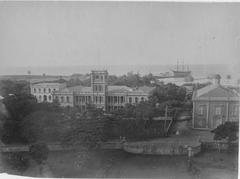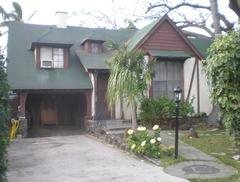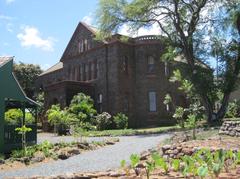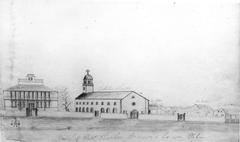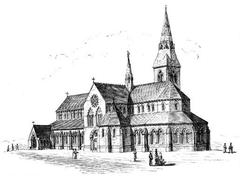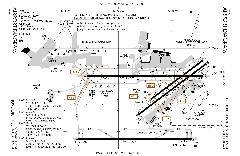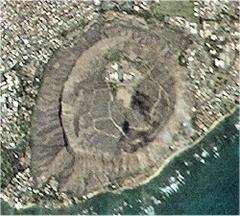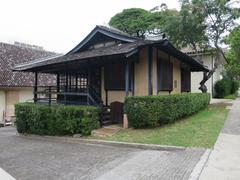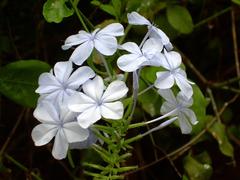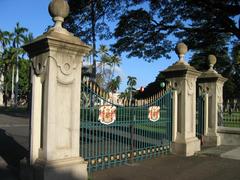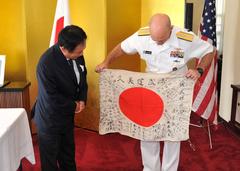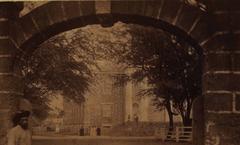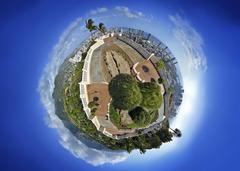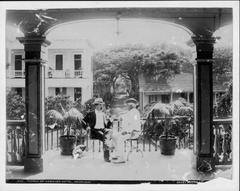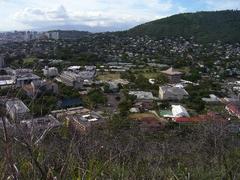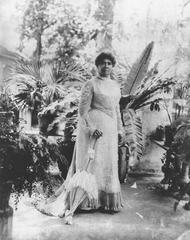
Hawaii Capital Historic District: Visiting Hours, Tickets, and Travel Guide
Date: 03/07/2025
Introduction
The Hawaii Capital Historic District, located in the heart of downtown Honolulu, is a vibrant testament to the islands’ political evolution, royal legacy, and architectural diversity. Since King Kamehameha III established Honolulu as Hawaii’s capital in 1845, the district has been home to monumental sites such as ʻIolani Palace—the only royal palace in the United States—Aliʻiōlani Hale, and the Hawaii State Capitol. Visitors will encounter an array of architectural styles, from early New England-inspired mission homes to Italian Renaissance Revival, Beaux Arts, Neoclassical, and mid-century Modernist structures uniquely influenced by Hawaiian symbolism. The district offers immersive opportunities for exploration, including guided and self-guided tours, cultural events, and educational programs that illuminate Hawaii’s monarchy, its transition to statehood, and ongoing preservation efforts (Wikipedia, ʻIolani Palace, TravelAge West).
Table of Contents
- Historical Overview
- Planning Your Visit
- Architectural Diversity and Cultural Highlights
- Visitor Experience and Practical Tips
- Frequently Asked Questions (FAQ)
- Preservation and Recognition
- Visual and Interactive Resources
- Conclusion and Travel Tips
- References
Historical Overview
Early Foundations and Monarchical Era
After King Kamehameha III moved the capital from Lahaina to Honolulu in 1845, the Hawaii Capital Historic District became the nucleus of Hawaiian governance and royal life (Wikipedia). Early structures like the Hawaiian Mission Houses—built by New England missionaries in the 1820s—reflect the district’s colonial beginnings and serve as some of the oldest Western-style buildings in Hawaii (TravelAge West). The crowning jewel of the monarchy era is ʻIolani Palace, completed in 1882 under King Kalākaua, which boasted technological innovations such as electric lighting and indoor plumbing before even the White House (TripSavvy). Today, visitors can tour its grand halls and learn about its role in the Hawaiian Kingdom’s final years.
Transition to Territorial and State Governance
Following the 1893 overthrow and Hawaii’s annexation as a U.S. territory, the district’s architectural landscape expanded to include Italian Renaissance Revival, Neoclassical, and Beaux Arts structures (Wikipedia). Landmarks such as Aliʻiōlani Hale (the State Supreme Court), the King Kalākaua Building, and Honolulu Hale (city hall) exemplify this period’s diversity (Historic Hawaii, Travelgasm). The YWCA Laniākea, designed by Julia Morgan, and the Mission Memorial Building further enrich the district’s architectural tapestry.
Modernist Reconfiguration and Statehood
With Hawaii’s statehood in 1959, urban planning in the district shifted toward modernism. The Hawaii State Capitol, completed in 1969, embodies Hawaiian natural symbolism with its open-air design and innovative use of space (LYS Law). The district now encompasses sites such as Washington Place (former home of Queen Liliʻuokalani), St. Andrew’s Cathedral, and Kawaiahaʻo Church, reflecting the intertwined legacies of royalty, religion, and civic leadership (Wikipedia).
Planning Your Visit
Visiting Hours and Tickets
- ʻIolani Palace: Tuesday–Saturday, 9:00 AM–4:00 PM; last entry at 3:00 PM. Adult tickets are $27; discounts available. Advance purchase recommended (ʻIolani Palace).
- Hawaiian Mission Houses: Tuesday–Saturday, 9:00 AM–4:30 PM. Adult admission is $12.
- Aliʻiōlani Hale: Exterior and grounds open for viewing; interior access is limited.
- Hawaii State Capitol: Monday–Friday, 7:00 AM–5:00 PM. Free admission (Hawaii State Capitol).
- Kawaiahaʻo Church and St. Andrew’s Cathedral: Free to visit during daylight hours.
Note: Always check official websites for updated hours and closures.
Accessibility
The district is highly walkable, with wide sidewalks and ramps at key sites. Most major attractions provide wheelchair access; check each location’s site for specifics.
Guided Tours and Special Events
- Guided Walking Tours: Offered by local organizations; provide deep historical context.
- Audio Tours: Available through mobile apps such as Audiala and GPSmyCity (GPSmyCity).
- Special Events: Annual celebrations include Statehood Day, Kamehameha Day, Lei Day, and cultural festivals (Hawaii State Capitol Events).
Nearby Attractions
- Chinatown: Eclectic dining and shopping district adjacent to the historic district.
- Aloha Tower Marketplace: Harborfront shopping and dining.
- Downtown Art Galleries: Including the Hawaii State Art Museum.
Architectural Diversity and Cultural Highlights
The Hawaii Capital Historic District displays an unparalleled range of architectural styles:
- Indigenous Hawaiian Influences: Use of lava rock, coral, and native woods, with open-air layouts (e-a-a.com).
- Italian Renaissance Revival & Greek Revival: Seen in ʻIolani Palace and Aliʻiōlani Hale.
- Spanish-Moorish & Mediterranean: Notable in the Royal Hawaiian Hotel and Honolulu Hale (Hawaii Magazine).
- Modernist: The Hawaii State Capitol epitomizes mid-20th-century innovation, integrating symbols of nature—volcano-shaped chambers, columns evoking palm trees, and reflecting pools.
- Public Art: Statues of Queen Liliʻuokalani and King Kamehameha I serve as cultural landmarks (Historic Hawaii).
Visitor Experience and Practical Tips
- Transportation: The district is easily accessible by foot, TheBus public transit, taxi, or ride-share. Parking is limited and metered.
- Dress Code: Modest attire is recommended, especially in sacred or government sites.
- Best Times to Visit: Early mornings or weekdays for fewer crowds. Shoulder seasons (April–June, September–November) offer ideal weather (Tourist Checklist).
- Amenities: Restrooms and water fountains are available at major sites; bring sunscreen, a hat, and water.
- Photography: Permitted outdoors; restrictions may apply inside historic buildings.
Frequently Asked Questions (FAQ)
Q: Is there an entrance fee to the Hawaii Capital Historic District?
A: The district is free to explore; some landmarks (e.g., ʻIolani Palace, Mission Houses) require tickets.
Q: Where can I buy ʻIolani Palace tickets?
A: Online in advance or at the ticket office; advance booking is strongly advised during busy periods (ʻIolani Palace).
Q: Are guided tours available?
A: Yes, at ʻIolani Palace, Mission Houses Museum, and the State Capitol.
Q: Is the district accessible for visitors with disabilities?
A: Most major sites provide wheelchair access; check specific sites for details.
Q: What are the best photographic spots?
A: ʻIolani Palace grounds, King Kamehameha statue, Hawaii State Capitol, and Aloha Tower.
Preservation and Recognition
Spanning 57 acres and more than 20 historic buildings, the Hawaii Capital Historic District is listed on the National Register of Historic Places (Wikipedia). Ongoing restoration and preservation efforts by government and community organizations ensure these sites endure for future generations (Historic Hawaii).
Visual and Interactive Resources
- Virtual Tours: Available on official websites like ʻIolani Palace and Mission Houses Museum (Mission Houses Museum).
- Interactive Maps: GPSmyCity’s Honolulu Downtown Walking Tour provides customizable routes (GPSmyCity).
Conclusion and Travel Tips
The Hawaii Capital Historic District offers a compelling journey through Hawaii’s royal past, political transformation, and enduring cultural identity. With accessible visiting hours, a wide range of ticket options, and both guided and self-guided tours, the district accommodates diverse interests. Its proximity to vibrant neighborhoods, cultural events, and botanical gardens further enriches the experience.
Preservation initiatives safeguard these treasures, while digital resources and mobile apps like Audiala deepen your exploration. Whether you’re a history buff, architecture lover, or casual traveler, the district invites you to connect with Hawaii’s story. Plan your visit today, check live schedules on official websites, and immerse yourself in the living narrative of Hawaii’s capital.
References
- Hawaii Capital Historic District – Wikipedia
- ʻIolani Palace Visitor Information
- 5 Must-See Historic Sites in Downtown Honolulu – TravelAge West
- Walking Tour of Historic Honolulu – TripSavvy
- Story Map Tour Event – Historic Hawaii
- Historic Walking Tours in Honolulu – LYS Law
- 10 Best Architectural Buildings in Honolulu – e-a-a.com
- 7 Examples of Honolulu Architecture at Its Finest – Hawaii Magazine
- Downtown Honolulu Walking Tour – GPSmyCity
- Hawaii State Capitol Official Website
- Honolulu Events Calendar




